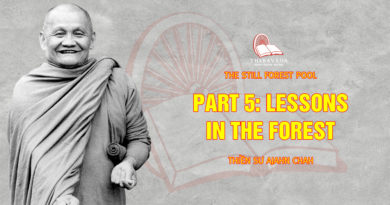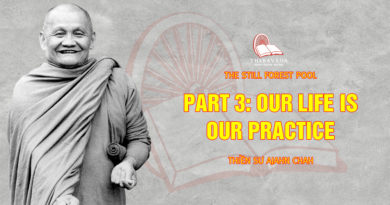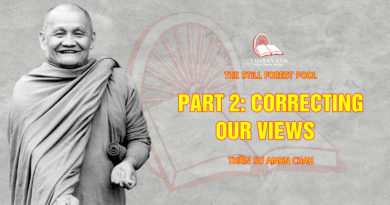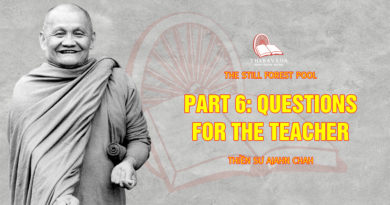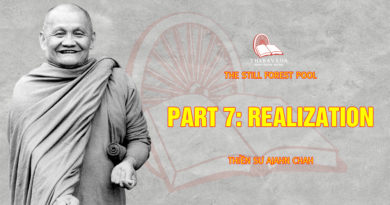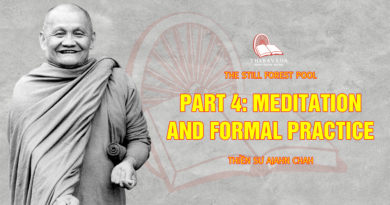PART 1
Understanding the Buddha’s Teachings
Achaan Chah asks us to begin our practice simply and directly with the understanding that the Buddha’s truths of suffering and liberation can be seen and experienced right here, within’ our own bodies, hearts, and minds. The eightfold path, * he tells us, is not to be found in books or scriptures but can be discovered in the workings of our own sense perceptions, our eyes, ears, nose, tongue, body, and mind. To study these in an immediate and wakeful way and cultivate mindfulness is the path of insight prescribed by the Buddha. It has been kept alive and followed by those monks, nuns, and laypeople inspired to devote themselves to practice in the centuries since.
Achaan Chah speaks as a contemporary living representative of this ancient teaching. His wisdom and mastery have not come through study or tradition but are born of his years of practice, his diligent effort to employ meditation to calm the heart and awaken the mind. His own practice was inspired and guided by the wisdom of several great forest masters a generation before him. And he invites us to follow their example and his.
Look at what makes up your world-the six senses, the processes of body and mind. These processes will become clear through examination and an ongoing training of attention. As you observe note how fleeting and impermanent are each of the sense objects which appear. You will see the conditioned tendency to grasp or to resist these changing objects. Here, teaches Achaan Chah, is the place to learn a new way, the path of balance, the Middle Path.
Achaan Chah urges us to work with our practice, not as an ideal, but in our everyday life situations. It is here that we develop strength to overcome our difficulties and a constancy and greatness of heart. It is here, he says, in each moment that we can step out of our struggle with life and find the inner meaning of right understanding and with it the peace of the Buddha.
The Simple Path
Traditionally the Eightfold Path is taught with eight steps such as Right Understanding, Right Speech, Right Concentration, and so forth. But the true Eightfold Path is within us-two eyes, two ears, two nostrils, a tongue, and a body. These eight doors are our entire Path and the mind is the one that walks on the Path. Know these doors, examine them, and all the dharmas will be revealed.
The heart of the path is SO simple. No need for long explanations. Give up clinging to love and hate, just rest with things as they are. That is all I do in my own practice.
Do not try to become anything. Do not make yourself into anything. Do not be a meditator. Do not become enlightened. When you sit, let it be. When you walk, let it be. Grasp at nothing. Resist nothing.
Of course, there are dozens of meditation techniques to develop samadhi and many kinds of vipassana. But it all comes back to this-just let it all be. Step over here where it is cool, out of the battle.
Why not give it a try? Do you dare?
The Middle Way
The Buddha does not want us to follow the double path-desire and indulgence on the one hand and fear and aversion on the other. Just be aware of pleasure, he teaches. Anger, fear, dissatisfaction are not the path of the yogi but the path of-worldly people. The tranquil person walks the Middle Path of right practice, leaving grasping on the left and fear and aversion on the right.
One who undertakes the path of practice must follow this Middle Way: “1 will not take interest in pleasure or pain. I will lay them down.” But, of course, it is hard at first. It is as though we are being kicked on both sides. Like a cowbell or a pendulum, we are knocked back and forth.
When Buddha preached his first sermon, he discoursed on these two extremes because this is where attachment lies. The desire for happiness kicks from one side; suffering and dissatisfaction kick from the other. These two are always besieging us. But when you walk the Middle Path, you put them both down.
Don’t you see? If you follow these extremes, you will simply strike out when you are angry and grab for what attracts you, without the slightest patience or forbearance. How long can you, go on being trapped in this way? Consider it: if you like something, you follow after it when liking arises, yet it is just drawing you on to seek suffering. This mind of desire is really clever. Where will it lead you next?
The Buddha teaches us to keep laying down the extremes. This is the path of right practice, the path leading out of birth and becoming. On this path, there is neither pleasure nor pain, neither good nor evil. Alas, the mass of humans filled with desiring just strive for pleasure and always bypass the middle, missing the Path of the Excellent One, the path of the seeker of truth. Attached to birth and becoming, happiness and suffering, good and evil, the one who does not travel this Middle Path cannot become a wise one, cannot find liberation. Our Path is straight, the path of tranquility and pure awareness, calmed of both elation and sorrow. If your heart is like this, you can stop asking other people for guidance.
You will see that when the heart / mind is unattached, it is abiding in its normal state. When it stirs from ‘the normal because of various thoughts and feelings, the process of thought construction takes place, in which illusions are created. Learn to see through this process. When the mind has stirred from normal, it leads away from right practice to one of the extremes of indulgence or aversion, thereby creating more illusion, more thought construction. Good or bad only arises in your mind. If-you keep a watch on your mind, studying this one topic your whole life, I guarantee that you will never be bored.
Ending Doubt
Many people who have studied on a university level and attained graduate degrees and worldly success find that their lives are still lacking. Though they think high thoughts and are intellectually sophisticated, their hearts are still filled with pettiness and doubt. The vulture flies high, but what does it feed on?
Dharma is understanding that goes beyond the conditioned, compounded, limited understanding of worldly science. Of course, worldly wisdom can be used to good purpose, but progress in worldly wisdom can cause deterioration in religion and moral values. The important thing is to develop super mundane wisdom that can use such technology while remaining detached from it.
It is necessary to teach the basics first-basic morality, seeing the transitoriness of life, the facts of aging and death. Here is where we must begin. Before you drive a car or ride a bicycle, you must learn to walk. Later, you may ride in an airplane or travel around the world in the blink of an eye.
Outward, scriptural study is not important. Of course, the Dharma books are correct, but they are not right. They cannot give you right understanding. To see the word hatred in print is not the same as experiencing anger, just as hearing a person’s name is different from meeting him. Only experiencing for yourself can give you true faith.
There are two kinds of faith. One is a kind of blind trust in the Buddha, the teachings, the master, which often leads one to begin practice or to ordain. The second is true faith-certain, unshakable-which arises from knowing within oneself. Though one still has other defilements to overcome, seeing dearly all things within oneself makes it possible to put an end to doubt, to attain this certainty in one’s practice.
Go Beyond Words: See for Yourself
In my own practice, I did not know or study much. I took the straightforward teachings the Buddha gave and simply began to study my own mind according to nature. When you practice, observe yourself. Then gradually knowledge and vision will arise of themselves. If you sit in meditation and want it to be this way or that, you had better stop right there. Do not bring ideals or expectations to your practice. Take your studies, your opinions, and store them away.
You must go beyond all words, all symbols, all plans for your practice. Then you can see for yourself the truth, arising right here. If you do not turn inward, you will never know reality. I took the first few years of formal Dharma text study, and when I had the opportunity, I went to hear various scholars and masters teach, until such study became more of a hindrance than a help. I did not know how, to listen to their sermons because I had not looked within.
The great meditation masters spoke about the truth within oneself. Practicing, I began to realize that it existed in my own mind as well. After a long time, I realized that these teachers have really seen the truth and that if we follow their path, we will encounter everything they have spoken about. Then we will be able to say, ”Yes, they were right. What else could there be? Just this.” When I practiced diligently, realization unfolded like that.
If you are interested in Dharma, just give up, just let go. Merely thinking about practice is like pouncing on the shadow and missing the substance. You need not study much. If you follow the basics and practice accordingly, you will see the Dharma for yourself. There must be more than merely hearing the words. Speak just with yourself, observe your own mind. If you cut off this verbal, thinking mind, you will have a true standard for judging. Otherwise, your understanding will not penetrate deeply. Practice in this way and the rest will follow.
Buddhist Psychology
One day, a famous woman lecturer on Buddhist metaphysics came to see Achaan Chah. This woman gave periodic teachings in Bangkok on the abhidharma and complex Buddhist psychology. In talking to Achaan Chah, she detailed how important it was for people to understand Buddhist psychology and how much her students benefited from their study with her. She asked him whether he agreed with the importance of such understanding.
“Yes, very important”, he agreed.
Delighted, she further questioned whether he had his own students learn abhidharma.
“Oh, yes, of course.”
And where, she asked, did he recommend they start, which books and studies were best?
“Only here,” he said, pointing to his heart, “only here.”
Study and Experiencing
Let us talk about the difference between studying Dharma ideas and applying them in practice. True Dharma study has only one purpose-to find a way out of the unsatisfactoriness of our lives and to achieve happiness and peace for ourselves and all beings. Our suffering has causes for its arising and a place to abide. Let us understand this process. When the heart is still, it is in its normal condition; when the mind moves, thought is constructed. Happiness and sorrow are part of this movement of mind, this thought construction. So also is restlessness, the desire to go’ here and there. If you do not understand such movement, you will chase after thought constructions and be at their mercy.
Therefore, the Buddha taught us to contemplate the movements of the mind. Watching the mind move, we can see its basic characteristics: endless flux, unsatisfactoriness and emptiness. You should be aware of and contemplate these mental phenomena. In this way, you can learn about the process of dependent origination. The Buddha taught that ignorance is the cause of the arising of all worldly phenomena and of our volitions. Volition gives rise to consciousness, and consciousness in turn gives rise to mind and body. This is the process of dependent origination.
When we first study Buddhism, these traditional teachings may appear to make sense to us. But when the process is actually occurring within us, those who have only read about it cannot follow fast enough. Like a fruit falling from a tree, each link in the chain falls so fast that such people cannot tell what branches it has passed. When pleasurable sense contact takes place, for example, they are carried away by the sensation and are unable to notice how it happened.
Of course, the systematic outline of the process in the texts is accurate, but the experience is beyond textual study. Study does not tell you that this is the experience of ignorance arising, this is how volition feels, this is a particular kind of consciousness, this is the feeling of the different elements of body and mind. When you let go of a tree limb and fall to the ground, you do not go into detail about how many feet and inches you fell; you just hit the ground and experience the pain. No book can describe that.
Formal Dharma study is systematic and refined, but reality does not follow a single track. Therefore, we must attest to what arises from the one who knows, from our deepest wisdom. When our innate wisdom, the one who knows, experiences the truth of the heart / mind, it will be dear that the mind is not our self. Not belonging to us, not I, not mine, ail of it must be dropped. As to our learning the names of all the elements of mind and consciousness, the Buddha did not want us to become attached to the words. He just wanted us to see that all this is impermanent, unsatisfactory, and empty of self. He taught only to let go. When these things arise, be aware of them, know them. Only a mind that can do this is properly trained.
When the mind is stirred up, the various mental formations, thought constructions, and reactions start arising from it, building and proliferating continually. Just let them be, the good as well as the bad. The Buddha said simply, “Give them up.” But for us, it is necessary to study our own minds to know how it is possible to give them up.
If we look at the model of the elements of mind, we see that it follows a natural sequence: mental factors are thus, consciousness arises and passes like this, and so forth. We can see in our own practice that when we have right understanding and awareness, then right thought, right speech, right action, and right livelihood automatically follow. Different mental elements arise from that very one who knows. The one who knows is like a lamp. If understanding is right, thought and all the other factors will be right as well, like the light emanating from the lamp. As we watch with awareness, right understanding grows.
When we examine all that we call mind, we see only a conglomeration of mental elements, not a self. Then where can we stand? Feeling, memory, all the five-aggregates of mind and body are shifting like leaves in the wind. We can discover this through meditation.
Meditation is like a single log of wood. Insight and investigation are one end of the log; calm and concentration are the other end. If you lift up the whole log, both sides come up at once. Which is concentration and which is insight? Just this mind.
You cannot really separate concentration, inner tranquility, and insight. They are just as a mango that is first green and sour, then yellow and sweet, but not two different fruits. One grows into the other without the first, we would never have the second. Such terms are only conventions for teaching; We should not be attached to the language. The only source of true knowledge is to see what is within ourself. Only this kind of study has an end and is the study of real value.
The calmness of the mind at the beginning stage of concentration arises from the simple practice of one pointedness. But when this calm departs, we suffer because we have become attached to it. The attainment of tranquility is not yet the end, according to the Buddha. Becoming and suffering still exist.
Thus, the Buddha took this concentration, this tranquility, and contemplated further. He searched out the truth of the matter until he was no longer attached to tranquility. Tranquility is just another relative reality, one of numerous mental formations, only a stage on the path. If you are attached to it, you will find yourself still stuck in birth and becoming, based on your pleasure in tranquility. When tranquility ceases, agitation will begin and you will be attached even more.
The Buddha went on to examine becoming and birth to see where they arise. As he did not yet know the truth of the matter, he used his mind to contemplate further, to investigate all the mental elements that arose. Whether tranquil or not, he continued to
penetrate, to examine further, until he finally realized that all that he saw, all the five aggregates of body and mind, were like a red-hot iron ball. When it is red-hot all over, where can you find a cool spot to touch? The same is true of the five aggregates-to grasp any part causes pain. Therefore, you should not get attached even to tranquility or concentration; you should not say that peace or tranquility is you or yours. To do so just creates the painful illusion of self, the world of attachment and delusion, another red-hot iron ball.
In our practice, our tendency is to grasp, to take experiences as me and mine. If you think, ‘1 am calm, I am agitated, I am good or bad, I am happy or unhappy,” this clinging causes more becoming and birth. When happiness ends, suffering appears; when suffering ends, happiness appears. You will see yourself unceasingly vacillating between heaven and hell. The Buddha saw that the condition of his mind was thus, and he knew, because of this birth and becoming, his liberation was not yet complete. So he took up these elements of experience and contemplated their true nature. Because of grasping, birth and death exist. Becoming glad is birth; becoming dejected is death. Having died, we are then born; having been born, we die. This birth and death from one moment to the next is like the endless spinning of a wheel.
The Buddha saw that whatever the mind gives rise to are just transitory, conditioned phenomena, which are really empty. When this dawned on him, he let go, gave up, and found an end to suffering. You too must understand these matters according to the truth. When you know things as they are, you will see that these elements of mind are a deception, in keeping with. the Buddha’s teaching that this mind has nothing, does not arise, is not born, and does not die with anyone. It is free, shining, resplendent, with nothing to occupy it. The mind becomes occupied only because it misunderstands and is deluded by these conditioned phenomena, this false sense of self.
Therefore, the Buddha had us look at our minds. What exists in the beginning? Truly, not anything. This emptiness does not arise and die with phenomena. When it contacts something good, it does not become good; when it contacts something bad, it does not become bad. The pure mind knows these objects clearly, knows that they are not substantial.
When the mind Of the meditator abides like this, no doubt exists. Is there becoming? Is there birth? We need not ask anyone. Having examined the elements of mind, the Buddha let them go and became merely one who was aware of them. He just watched with equanimity. Conditions leading to birth did not exist for him. With his complete knowledge, he called them all impermanent, unsatisfactory, empty of self. Therefore, he became the one who knows with certainty. The one who knows sees according to this truth and does not become happy or sad according to changing conditions. This is true peace, free of birth, aging, sickness, and death, not dependent on causes, results, or conditions, beyond happiness and suffering, above good and evil. Nothing can be spoken about it. No conditions promote it any longer.
Therefore, develop samadhi, calm and insight; learn to make them arise in your mind and really use them. Otherwise, you will know only the words of Buddhism and with the best intentions, go around merely describing the characteristics of existence. You may be clever, but when things arise in your mind, will you follow them? When you come into contact with something you like, will you immediately become attached? Can you let go of it? When unpleasant experiences arise, does the one who knows hold that dislike in his mind, or does he let go? If you see things that you dislike and still hold on to or condemn them, you should reconsider-this is not yet correct, not yet the supreme. If you observe your mind in this way, you will truly know for yourself.
I did not practice using textbook terms; I just looked at this one who knows. If it hates someone, question why. If it loves someone, question why. Probing all arising back to its origin, you can solve the problem of clinging and hating and get them to leave you alone. Everything comes back to and arises from the one who knows. But repeated practice is crucial.
The Chicken or the Egg?
During his first visit to England, Achaan Chah spoke to many Buddhist groups. One evening after a talk he received a question from a dignified English lady who had spent many years studying the complex cybernetics of the mind according to the eighty-nine classes of consciousness in the Buddhist abhidharma psychology texts. Would he please explain certain of the more difficult aspects of this system of psychology to her so she could continue her study?
Dharma teaches us to let go. But at first, we naturally cling to the principles of Dharma. The wise person takes these principles and uses them as tools to discover the essence of our life.
Sensing how caught up she was in intellectual concepts rather than benefiting from practice in her own heart, Achaan Chah answered her quite directly, ”You, madam, are like one who keeps hens in her yard,” he told her, “and goes around picking up the chicken droppings instead of the eggs.”
Thieves in Your Heart
The purpose of meditation is to raise things up and put them to the test, to understand their essence. For example, we see the body as something fine and beautiful, whereas the Buddha tells us it is unclean, impermanent, and prone to suffering. Which view accords with the truth?
We are like visitors to a foreign country; not knowing the language, we cannot enjoy ourselves. But once we have learned the language, we can laugh and joke with others. Or we are like children who have to grow up before we can understand what the grownups are saying.
The normal view is that the elements of our life, beginning with the body, are stable. One child plays with his balloon until it catches on a branch or a thorn and bursts, leaving him in tears. Another child, smarter than the first, knows that his balloon can burst easily and is not upset when it does. People go through life blindly, ignoring the fact of death like gourmets feasting on fine foods, never thinking they will have to excrete. Then nature calls, but having made no provision, they do not know where to go. There is danger in the world-danger from the elements, danger from thieves. These dangers have their counterpart in the temples too. The Buddha taught us to investigate these dangers and gave the name bhikkhu to one who ordains. Bhikkhu has two meanings: one who begs and one who sees danger in the round of samsara, of grasping. Beings experience greed, hatred, and delusion. Succumbing to these defilements, they reap the results, increase their bad habits, make yet more karma, and again succumb to defilements.
Why can’t you get rid of greed, hatred, and delusion? If your thinking is wrong, you will suffer; if you understand correctly, you can end suffering.
Know the workings of karma, of cause and effect. Attachment to pleasure brings suffering in its wake. You gorge yourself on good food, but stomach trouble and intestinal discomfort follow. Or you steal something and are happy with it, but later the police come around to arrest you. When you watch, you can learn how to act, you can learn to end grasping and sorrow. The Buddha, seeing this, wanted to escape from the real dangers of the world, which we have to overcome within ourselves. External dangers are not as frightening as the dangers within: What are the elements of this inner danger?
Wind. Things come at the senses, causing compulsion, lust, anger, and ignorance to arise, destroying what is good in us. Normally, we see the wind only as that which blows the leaves about, not seeing the wind of our senses, which, unwatched, can cause the storms of desire.
Fire. Our temple may never have been struck by fire, but greed, hatred, and delusion burn us constantly. Lust and aversion cause us to speak and do wrong; delusion leads us to see good as bad, bad as good, .the ugly as beautiful, the valueless as valuable. But one who does not meditate does not see this and is overcome by these fires.
Water. Here the danger is the flood of defilement in our hearts submerging our true nature.
Thieves. The real thieves do not exist outside us. Our monastery has seen thieves only once in twenty years, but inwardly the five gangs of attachment, the aggregates, are ever robbing, beating, and destroying us. What are these five aggregates?
1. Body. It is a prey to illness and pain; when it does not accord with our wishes, we have grief and sorrow. Not understanding the natural aging and decay of the body, we suffer. We feel attraction or repulsion toward the bodies of others and are robbed of true peace.
2. Feelings. When pain and pleasure arise, we forget that they are impermanent, suffering, not self; we identify with our emotions and are thus tortured by our wrong understanding.
3. Memories and perceptions. Identifying with what we recognize and remember gives rise to greed, hatred, and delusion. Our wrong understanding becomes habitual, stored in the subconscious.
4. Volitions and other elements of mind. Not understanding the nature of mental states, we react, and thoughts and feelings, likes and dislikes, happiness and sorrow arise. Forgetting that they are impermanent, suffering, and selfless, we cling to them.
5. Consciousness. We grasp that which knows the other aggregates. We think, “I know, I am, I feel,” and are bound by this illusion of self, of separation.
All these thieves, this wrong understanding, leads to wrong action. The Buddha had no desire for this; he saw that there was no true happiness to be found here. Thus, he gave the name bhikkhu to those who also see this danger and seek a way out.
The Buddha taught his monks the true nature of the five aggregates and how to let go of them without clinging to them as me or mine. When we understand them, we will see that they have potential for great harm or great value, but they do not disappear. They are simply no longer grasped as our own. After his enlightenment, the Buddha still had physical ills, had feelings of pain and pleasure, had memories, thoughts, and consciousness. But he did not cling to them as being self, as being me or mine. He knew them as they were, and the one who knew was also not I, not self.
Separating the five aggregates from the defilements and from clinging is like clearing the brush in the forest without destroying the trees. There is just a constant arising and falling away; defilement cannot gain a foothold. We are simply being born and dying with the aggregates; they just come and go, according to their nature.
If someone curses us and we have no feelings of self, the incident ends with the spoken words, and we do not suffer. If unpleasant feelings arise, we should let them stop there, realizing that the feelings are not us. ” He hates me, he troubles me, he is my enemy.” A bhikkhu does not think like this, nor does he hold views of pride or comparison. If we do not stand up in the line of fire, we do not get shot; if there is no one to receive it, the letter is sent back. Moving gracefully through the world not caught in evaluating each event, a bikkhu becomes serene. This is the way of NirVana, empty and free
Investigate the five aggregates, then; make a clean forest. You will be a different person. Those who understand emptiness and practice accordingly are few, but they come to know the greatest joy. Why not try it? You can abolish the thieves in your heart and set everything right.
______________________


